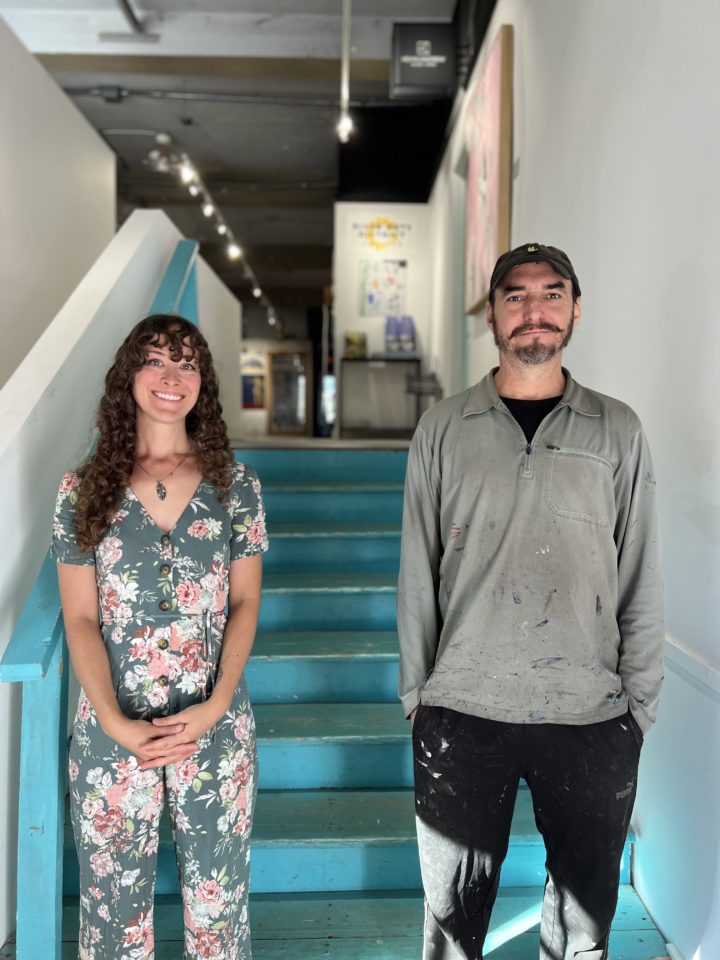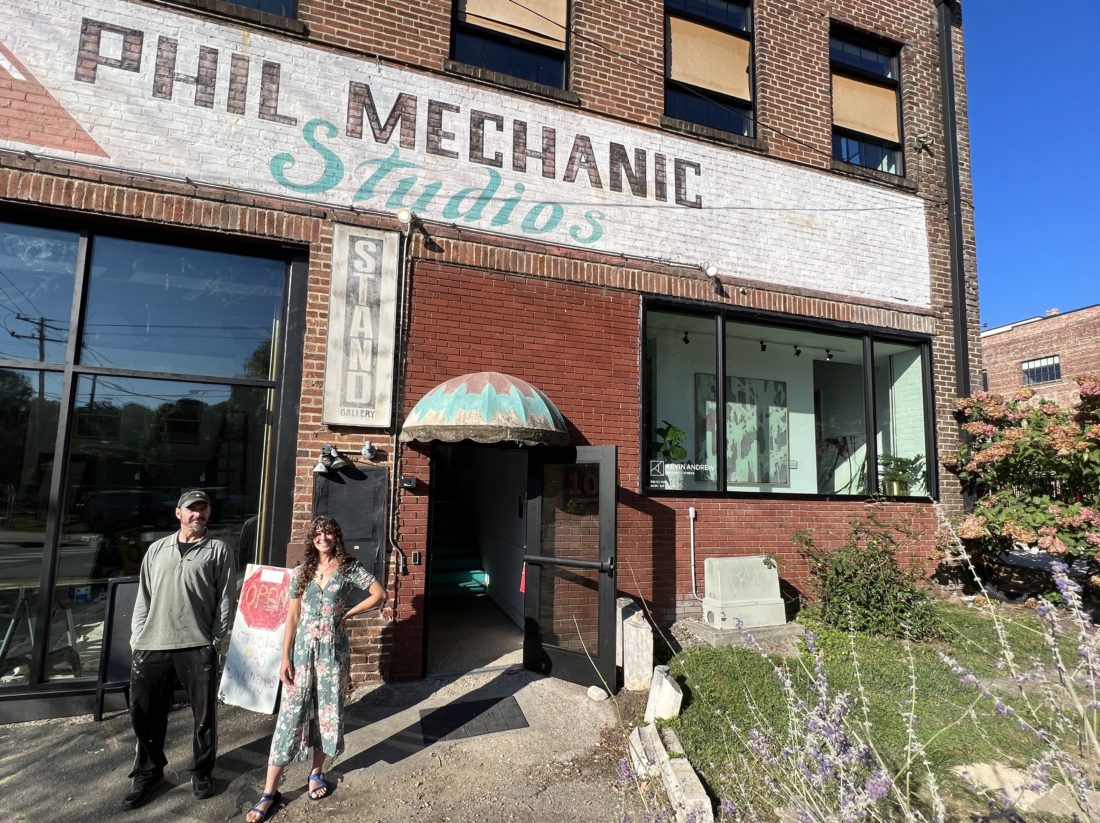Asheville-based painter and longtime Phil Mechanic Studios tenant Stephen Lange jokes about the building being the Millennium Falcon of the River Arts District.
“It’s the fastest hunk of junk in the galaxy,” he says. “People come down here from New York City, Miami, Germany. And if they’re curious about art and they want to see something they’ve never seen before, we have the most awesome conversations.”
But while Lange has been called Han Solo over the years, he says he’s more like Chewbacca when it comes to metaphorically “knowing where to hit [the walls] to make the light come back on” and helping keep the historic Roberts Street building active.
Maintaining both reputations hasn’t been easy, especially with multiple ownership changes over Lange’s decade of working inside the building. But after surviving rampant uncertainty, the spot lovingly dubbed “the Phil” by its tenants and clientele is resembling its old self — albeit with some much-needed renovations over the past year.
Though it never officially closed during the COVID-19 pandemic or in the midst of upgrades, the Phil will hold a symbolic grand reopening celebration on Saturday, Oct. 14, to reintroduce the building and its new roster of artists. The date coincides with the River Arts District Artists’ Second Saturday series, which encourages the public to tour open studios and meet working creatives.
Enduring appeal
In 2014, Lange began renting an upstairs studio space in the Phil. Within a year, he moved to a first-floor room and took on the role of property manager — a position he kept when the building was sold to Texas-based developer James Lifshutz in 2016.
Over the next few years, Lange sustained the building as a home for working artists. But his management position was phased out in 2019, shortly after the building sold to Phil Mechanic Building LLC. Within a year, the Phil was sold again to the Atlanta-based commercial real estate firm Hatteras Sky. By then only four tenants (all artists) remained.
Lange attributes the exodus to the LLC’s lack of vision for the Phil and the company’s unwillingness to offer long-term leases to artists. But this March, as construction on The Radical (a hotel in the RAD, which Hatteras Sky also owns) wound down, management began actively advertising the Phil to new tenants and offering yearlong terms.
Lange’s current suite 3C studio originally cost $600 per month on a month-to-month basis. As of August, he has a year lease with Hatteras Sky and pays $1,600 for it and suite 3D, which he uses for storage. Hatteras Sky manager Amy Michaelson Kelly notes that rents throughout the building vary. Lange’s units, she says, have good access to the street and are considered premium spaces.
But the increased rates haven’t scared him away; nor have they influenced fellow tenant and painter Rebecca Harnish. She’s worked in the Phil since 2019, beginning in a tucked-away downstairs studio in a space known as the “Cooler.” The name, Harnish explains, pays homage to the building’s original owner. Opened in 1928, the site housed Pearce-Young-Angel Co., a South Carolina-based food distribution business; the basement was where nearly frozen perishables were stored.
More recently, Harnish upgraded to a street-level studio. “It’s been a very special place to me as my very first art studio — the only one I could reasonably afford in Asheville at the time — and now somewhere I can show my work to the world,” Harnish says. “It’s always had a Wild West kind of vibe, full of some of the most creative and unique people in town, in my opinion.”
Part of that charm has been its grungy, industrial feel. But she adds that with that ambiance came plenty of broken windows, long-forgotten storage and a leaky roof.
“It definitely needed some attention and love, and I’m glad to see the building restored a bit,” Harnish says. “After heavy rains, multiple studios would have water leaking in.”
‘Control and spontaneity’
According to Kelly, completed repairs to the Phil in 2023 include the following: a new roof and new windows across the front of the building; adding modular heating and air conditioning to almost all spaces; new lighting; improved Wi-Fi; new interior paint; security devices and upgraded locks for all spaces; adding common area furniture; and updated bathrooms.

“Right now, we are installing heating and air in the common spaces such that the entire usable area building is conditioned. This work should be completed this fall,” Kelly says.
Additional plans for 2024 include the launch of an Israeli restaurant on the first floor. Unlike recent construction, Kelly says, future renovations on the new eatery should not impede studios and businesses inside the Phil.
That’s good news for Harnish, who weathered a sharp dip in sales during the COVID-19 pandemic. Because of restrictions, Harnish focused on her online presence and found creative ways to interact with outdoor shoppers amid social distancing. She adds that offering accessible prices on prints and cards helped sustain sales and that the break from her usual routine proved beneficial for her creativity.
“[My studio] was an absolute haven during the pandemic, somewhere I could escape from my home and feel safe in,” she says. “The heavy industrial refrigeration door that separated the ‘Cooler’ studios from the rest of the building made the space feel like an impenetrable fortress. It was a time of incubation of ideas, and now those ideas get to see fruition and exhibition.”
While her work has long been inspired by her travels and hikes all over the U.S., lately Harnish has been increasingly fascinated by local landscapes, flora and fauna.
“The incredible lushness and biodiversity of the Appalachian Mountains is what drew me away from the West, and I find endless inspiration in the textures created by fields of wildflowers, dappled light filtering through layers of forest canopy and the depths of mountains receding into the dewy atmosphere,” she says. “I love using watercolor to capture nature, as [it’s] a medium that lends itself to both control and spontaneity.”
The next chapter
As of press time, Kelly says that of the 30 available spaces in the building, 28 are leased. Artists occupy all but four studios.
“We intend for this to remain a creative space for artist studios, galleries and small businesses and to add a casual restaurant with elevated cuisine,” Kelly says. “These uses provide a great amenity for The Radical and the RAD in general.”
Harnish says she is thrilled to see its studios filling back up, even as lease rates become more in line with other studio spaces around Asheville.
“As more and more artists start renting space and showing again, it’s starting to feel like more of a community again — a blank canvas to be turned into something beautiful,” she says.
Lange believes it’s important for artists to keep working studios and be present rather than just display in a gallery and not be present when potential patrons view their work.
“The artist dealing direct with the person who’s going to buy a painting, it keeps the artist honest, it keeps them humble and lets them hopefully develop a relationship with the person that’s going to have their creation for the rest of your lives,” Lange says.
He adds that it’s specifically tourists from New York City who, upon spending a few minutes in his studio, remark that they miss getting to see and interact with the artist whose work is on display.
“I’m genuinely glad to take the distraction and talk to people that are visiting Asheville,” he says. “The conversations that I have with people that are simply curious, they’re very meaningful as well as deeply spiritual — and hilarious.”
Though neither artist has anything extravagant planned for the Oct. 14 reopening celebration — “snacks, drinks: pretty standard art opening stuff,” Lange says — both are optimistic about the impact that The Radical will have on their block of Roberts Street and the RAD overall. Lange sees the hotel as the potential source of a steady stream of patrons and an improvement over the structure sitting empty, a sentiment with which Harnish agrees.
“It’s such a far cry from the decrepit-looking historical building that had so much potential being wasted. It’s really beautiful now,” she says. “For the Phil, it feels like the start of something special on our little corner of the RAD — which, to me, has always felt like a bit of an outlier. I think the hotel will have a very positive impact on the studios and artists working there.”




Before you comment
The comments section is here to provide a platform for civil dialogue on the issues we face together as a local community. Xpress is committed to offering this platform for all voices, but when the tone of the discussion gets nasty or strays off topic, we believe many people choose not to participate. Xpress editors are determined to moderate comments to ensure a constructive interchange is maintained. All comments judged not to be in keeping with the spirit of civil discourse will be removed and repeat violators will be banned. See here for our terms of service. Thank you for being part of this effort to promote respectful discussion.